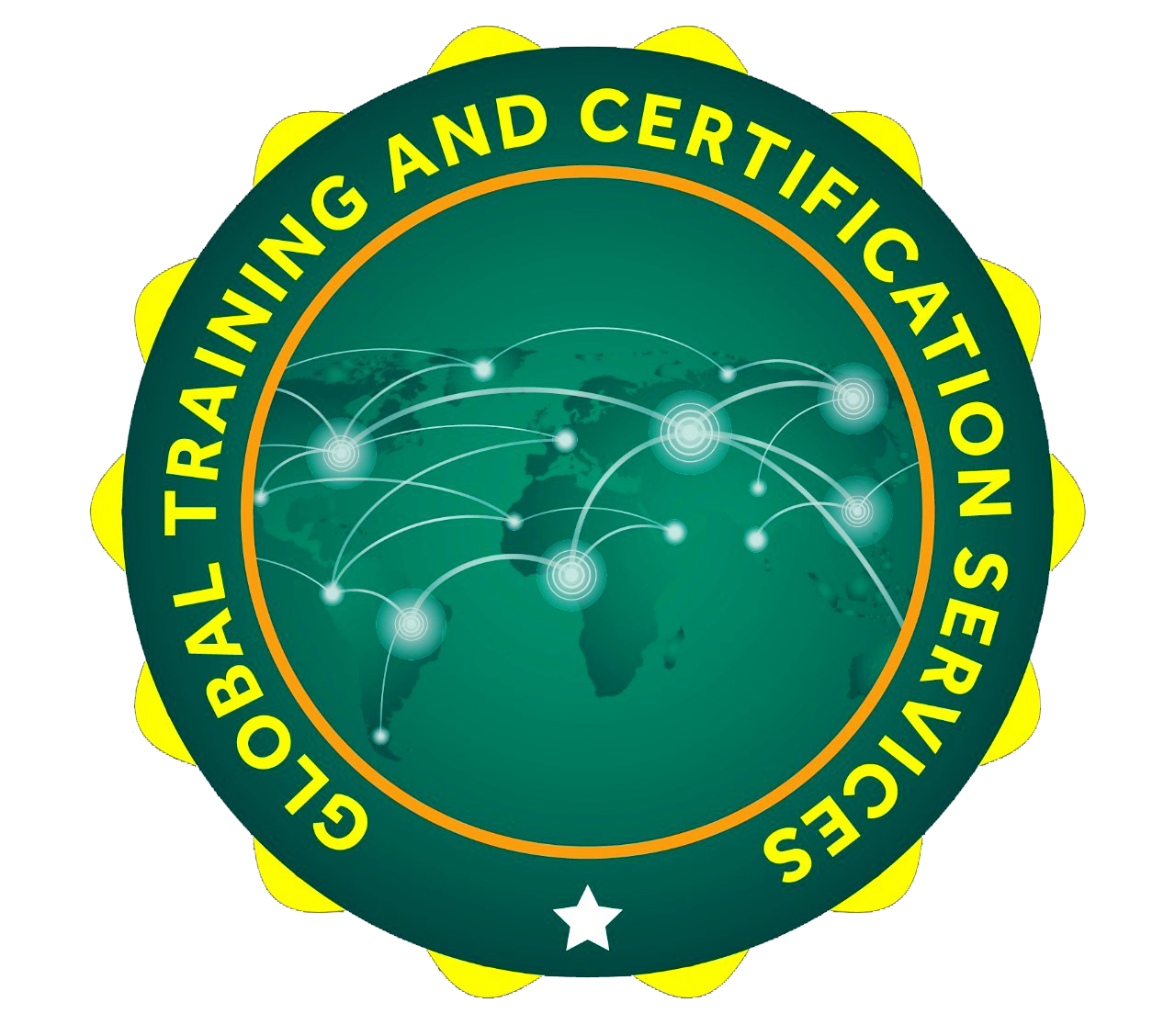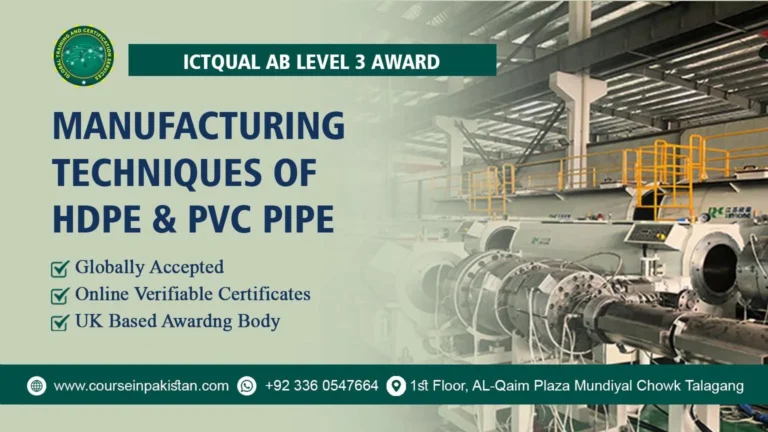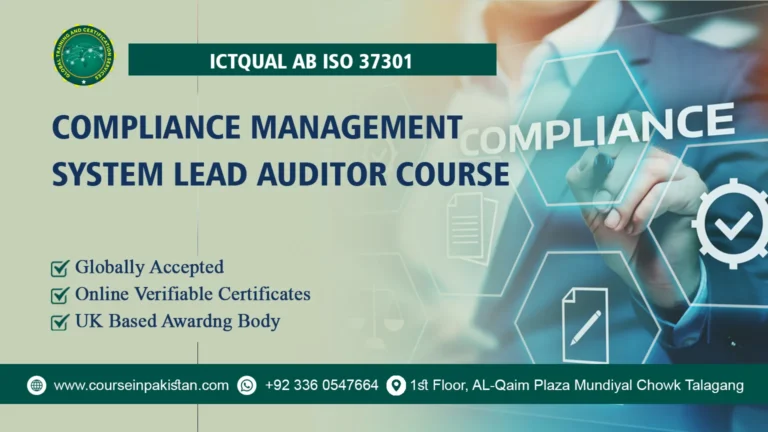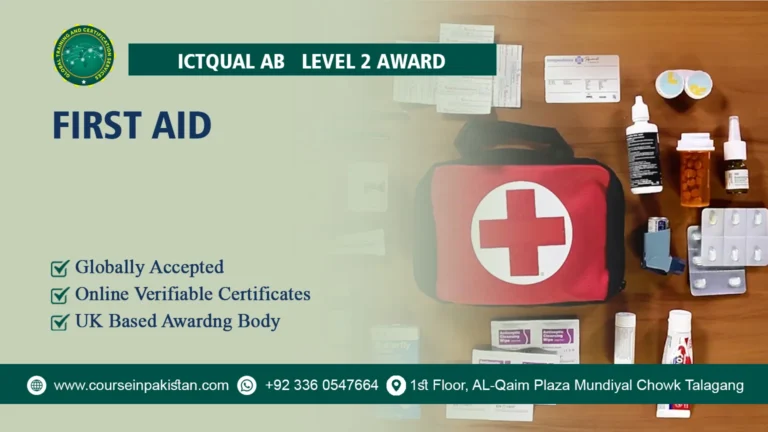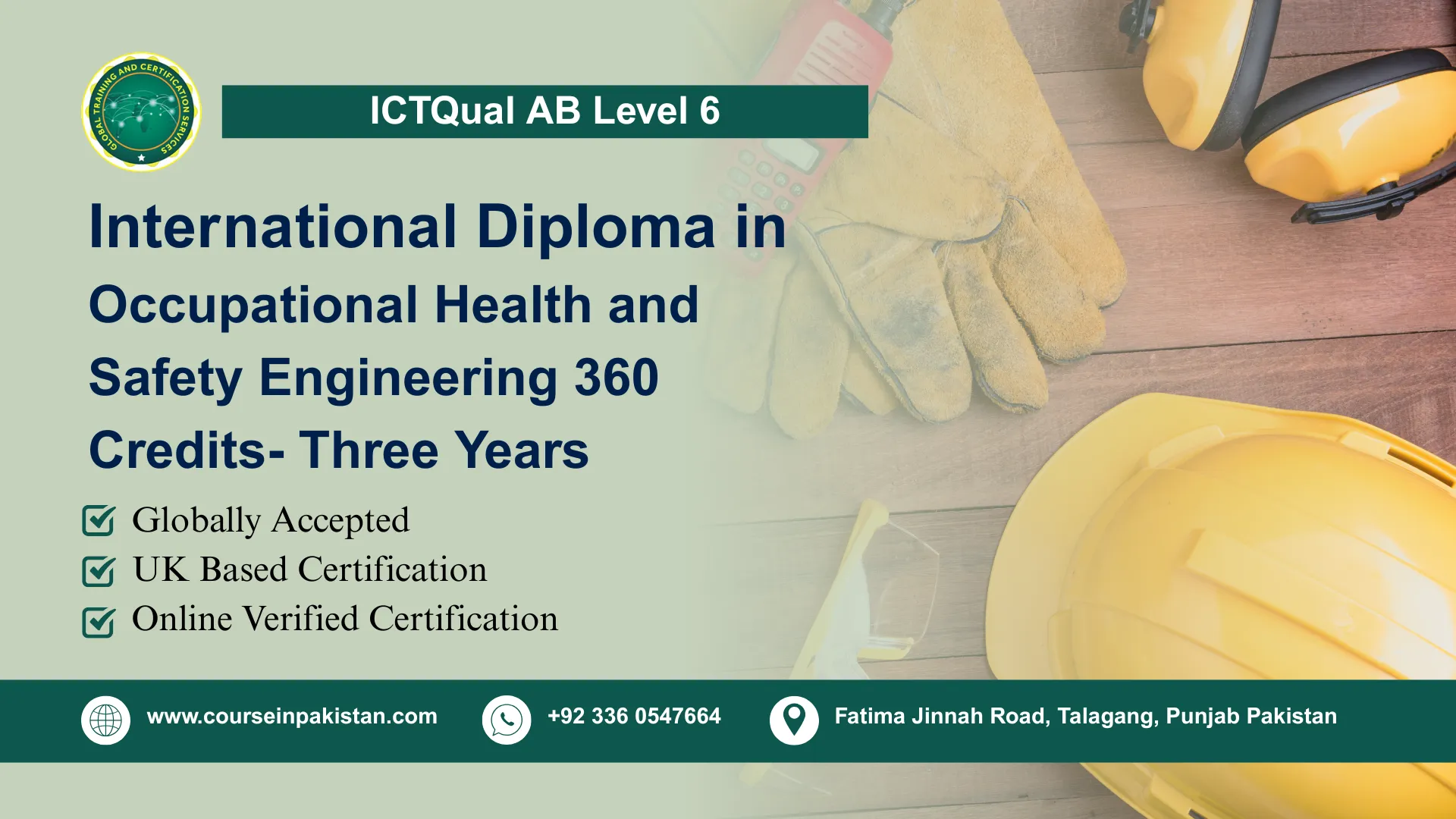
The ICTQual AB Diploma in Occupational Health and Safety Engineering (360 Credits – Three Years) is a comprehensive and globally recognized qualification designed to equip learners with in-depth knowledge and practical skills in occupational health and safety (OHS) engineering. This diploma is structured to cater to a wide range of learners, including fresh graduates, professionals seeking career advancement, and industry practitioners aiming to enhance their expertise.
This qualification emphasizes modern safety management practices, hazard identification, risk assessment, and regulatory compliance in various industries. By integrating engineering principles with health and safety standards, learners gain the competencies required to manage workplace safety effectively and contribute to organizational risk mitigation strategies.
With a flexible, assignment-based structure, this diploma allows learners to study at their own pace from anywhere in the world, making it an ideal choice for professionals balancing work and education. Upon completion, learners receive a certification that is British Council verifiable, MOFA and Embassy attestable, ensuring global recognition and credibility.
Course Overview
Key Highlights of the Course:
- 360-credit, three-year diploma suitable for self-paced learning from anywhere in the world.
- Assignment-based structure, allowing learners to manage studies alongside work commitments.
- British Council verifiable and MOFA & Embassy attestable, ensuring global recognition.
- Fast-track option for experienced professionals with at least 6 years of relevant experience.
- Ideal for job placement, career advancement, and iqama approval in multiple industries.
Course Benefits
1. Career Advancement Opportunities
- Gain internationally recognized qualifications that open doors to leadership and managerial roles in occupational health and safety.
- Enhance employability in industries such as oil & gas, construction, manufacturing, and engineering.
2. Flexibility and Convenience
- Complete the course entirely online and at your own pace, accommodating busy schedules and global learners.
- No need for physical attendance; suitable for professionals working full-time.
3. Fast-track Option for Experienced Professionals
- Professionals with 6+ years of relevant experience can earn the diploma without completing all mandatory assignments.
- Validate expertise through professional discussion meetings with an ICTQual AB approved assessor.
4. Global Recognition and Credibility
- Certification is British Council verifiable, MOFA and Embassy attestable, enhancing credibility in international career applications.
- Ideal for iqama approval and professional recognition in the Middle East and worldwide.
5. Comprehensive Skill Development
- Develop critical skills in risk assessment, hazard control, safety management systems, and compliance with international OHS standards.
- Learn practical strategies to reduce workplace accidents, protect employees, and ensure organizational safety.
Course Study Units
This qualification, the ICTQual AB Diploma in Occupational Health and Safety Engineering 360 Credits- Three Years, consists of 36 mandatory units.
Year 1 – Foundation Level
- Introduction to Occupational Health and Safety
- Principles of Risk Assessment and Management
- Workplace Safety Legislation and Compliance
- Fundamentals of Fire Safety Management
- Personal Protective Equipment (PPE) in the Workplace
- Environmental Health and Safety Awareness
- Accident Investigation and Reporting Procedures
- Ergonomics and Human Factors in Safety
- Health and Safety Communication Skills
- Hazard Identification and Control Measures
- Basics of Industrial Hygiene
- Introduction to Emergency Preparedness and Response
Year 2 – Intermediate Level
- Advanced Risk Assessment Techniques
- Fire Safety Systems and Evacuation Planning
- Safety Management Systems (ISO 45001)
- Workplace Safety Auditing and Inspection
- Electrical Safety in the Workplace
- Mechanical and Machinery Safety
- Environmental Protection and Sustainability Practices
- Occupational Health Monitoring and Surveillance
- Safety Leadership and Team Management
- Hazardous Materials and Chemical Safety
- Noise, Vibration, and Occupational Stress Management
- Construction and Industrial Safety Practices
Year 3 – Advanced Level
- Strategic Health and Safety Management
- Advanced Fire Risk Management and Prevention
- Safety Culture Development and Behavioural Safety
- Advanced Accident Investigation and Root Cause Analysis
- Ergonomic Risk Management in Industrial Settings
- Emergency Planning and Crisis Management
- Safety Performance Metrics and KPI Analysis
- Legal Compliance and Occupational Safety Standards
- Environmental Health and Safety Policy Development
- Health and Safety Project Planning and Implementation
- Leadership in Occupational Safety Engineering
- Capstone Project in Occupational Health and Safety Engineering
Learning Outcomes
Year 1 – Foundation Level
- Introduction to Occupational Health and Safety
- Explain fundamental principles of occupational health and safety (OHS).
- Identify key hazards and safety practices in various workplace environments.
- Principles of Risk Assessment and Management
- Conduct basic risk assessments and evaluate potential workplace hazards.
- Apply risk management strategies to prevent accidents and injuries.
- Workplace Safety Legislation and Compliance
- Interpret local and international OHS laws and regulations.
- Ensure organizational practices comply with legal safety requirements.
- Fundamentals of Fire Safety Management
- Understand fire hazards and prevention measures.
- Implement basic fire safety procedures and emergency responses.
- Personal Protective Equipment (PPE) in the Workplace
- Identify appropriate PPE for different work environments.
- Demonstrate correct usage and maintenance of PPE.
- Environmental Health and Safety Awareness
- Recognize environmental risks and hazards in the workplace.
- Promote safety and environmental awareness among employees.
- Accident Investigation and Reporting Procedures
- Conduct basic accident investigations and identify causes.
- Prepare accurate accident reports and suggest corrective actions.
- Ergonomics and Human Factors in Safety
- Identify ergonomic risks in workplace design and operations.
- Apply human factors principles to improve safety and productivity.
- Health and Safety Communication Skills
- Communicate OHS policies and procedures effectively.
- Educate colleagues about safety protocols and practices.
- Hazard Identification and Control Measures
- Recognize workplace hazards across different industries.
- Implement control measures to mitigate or eliminate risks.
- Basics of Industrial Hygiene
- Understand the principles of industrial hygiene and workplace health.
- Monitor and assess exposure to hazardous substances.
- Introduction to Emergency Preparedness and Response
- Develop basic emergency response plans.
- Respond effectively to workplace emergencies and hazards.
Year 2 – Intermediate Level
- Advanced Risk Assessment Techniques
- Conduct detailed risk analyses for complex workplace scenarios.
- Prioritize hazards and implement effective control measures.
- Fire Safety Systems and Evacuation Planning
- Design and evaluate fire detection and suppression systems.
- Plan and manage evacuation procedures in emergency situations.
- Safety Management Systems (ISO 45001)
- Develop, implement, and maintain OHS management systems.
- Ensure compliance with ISO 45001 standards and continual improvement.
- Workplace Safety Auditing and Inspection
- Conduct systematic safety audits and workplace inspections.
- Identify non-compliance issues and recommend corrective actions.
- Electrical Safety in the Workplace
- Apply safe practices when working with electrical systems.
- Assess electrical risks and implement preventive measures.
- Mechanical and Machinery Safety
- Identify hazards associated with machinery and equipment.
- Apply safety controls to reduce mechanical risks.
- Environmental Protection and Sustainability Practices
- Integrate environmental sustainability into workplace safety practices.
- Promote environmentally responsible procedures within organizations.
- Occupational Health Monitoring and Surveillance
- Monitor employees’ health in relation to workplace hazards.
- Implement surveillance programs to prevent occupational illnesses.
- Safety Leadership and Team Management
- Lead safety initiatives and encourage safe work behavior.
- Manage teams to ensure compliance with OHS policies.
- Hazardous Materials and Chemical Safety
- Handle and store hazardous substances safely.
- Implement chemical safety protocols and risk controls.
- Noise, Vibration, and Occupational Stress Management
- Assess and control noise, vibration, and stress risks.
- Promote employee well-being through mitigation strategies.
- Construction and Industrial Safety Practices
- Apply safety procedures in construction and industrial sites.
- Implement risk management strategies specific to high-risk industries.
Year 3 – Advanced Level
- Strategic Health and Safety Management
- Develop organizational safety strategies aligned with corporate goals.
- Evaluate long-term safety performance and implement improvements.
- Advanced Fire Risk Management and Prevention
- Analyze complex fire hazards and plan mitigation strategies.
- Implement advanced fire prevention and control measures.
- Safety Culture Development and Behavioural Safety
- Foster a positive safety culture within the organization.
- Apply behavioral safety techniques to influence employee safety practices.
- Advanced Accident Investigation and Root Cause Analysis
- Conduct in-depth investigations to identify underlying causes of accidents.
- Recommend long-term corrective and preventive actions.
- Ergonomic Risk Management in Industrial Settings
- Evaluate and manage ergonomic risks in complex industrial environments.
- Implement solutions to enhance productivity and reduce workplace injuries.
- Emergency Planning and Crisis Management
- Develop comprehensive emergency and crisis management plans.
- Coordinate responses during organizational emergencies.
- Safety Performance Metrics and KPI Analysis
- Measure and analyze safety performance using KPIs and metrics.
- Use data to drive continuous improvement in OHS practices.
- Legal Compliance and Occupational Safety Standards
- Ensure compliance with national and international OHS laws and standards.
- Conduct reviews to identify gaps and maintain legal adherence.
- Environmental Health and Safety Policy Development
- Develop organizational EHS policies and procedures.
- Align policies with sustainability and regulatory requirements.
- Health and Safety Project Planning and Implementation
- Plan, execute, and monitor OHS projects effectively.
- Manage resources, timelines, and outcomes to achieve safety objectives.
- Leadership in Occupational Safety Engineering
- Demonstrate leadership in promoting workplace safety culture.
- Guide teams and stakeholders to implement OHS strategies effectively.
- Capstone Project in Occupational Health and Safety Engineering
- Integrate knowledge from all units to complete a comprehensive OHS project.
- Apply problem-solving, analysis, and strategic planning skills in real-world scenarios.
Who is This Course For?
1. Fresh Graduates and Entry-Level Professionals
- Individuals seeking a strong foundation in occupational health and safety engineering.
- Those aiming to develop practical knowledge in workplace risk assessment, safety compliance, and hazard management.
2. Experienced Safety Professionals
- Professionals with at least 6 years of relevant industry experience looking to fast-track certification.
- Individuals aiming to validate their expertise through professional discussion and assessment without completing all assignments.
3. Career Switchers or Industry Changers
- Individuals from related engineering, industrial, or management backgrounds who want to enter the OHS field.
- Learners seeking globally recognized certification for international career opportunities and iqama approval.
4. Self-Motivated and Flexible Learners
- Those who prefer assignment-based, self-paced learning from anywhere in the world.
- Individuals able to manage deadlines and demonstrate practical understanding through assignments and assessments.
Future Progression
- Advance to senior roles such as Occupational Health and Safety Manager, Safety Engineer, or HSE Consultant.
- Lead organizational safety strategies and implement OHS policies at corporate or industrial levels.
- Opportunities to work in high-risk industries like oil & gas, construction, manufacturing, and utilities.
- Potential to pursue further international certifications or specialized OHS training programs.
- Serve as an expert witness or safety advisor for audits, compliance, and regulatory inspections.
Academic Pathways:
- Progress to postgraduate diplomas or master’s programs in Occupational Health and Safety, Risk Management, or Industrial Engineering.
- Enroll in specialized certifications such as ISO 45001 Lead Auditor, Fire Safety Management, or Environmental Health and Safety Programs.
- Bridge into management and leadership programs to combine OHS expertise with organizational strategy.
- Explore research opportunities in occupational safety, industrial ergonomics, and workplace health sciences.
Conclusion
The ICTQual AB Diploma in Occupational Health and Safety Engineering is a highly flexible, assignment-based program designed to equip learners with the expertise, practical skills, and strategic knowledge needed to excel in OHS roles worldwide. Suitable for both fresh graduates and experienced professionals, the course provides international recognition, MOFA and Embassy attestation, and British Council verification, making it ideal for career advancement, job placements, and iqama approval. By completing this diploma, learners gain the competence to lead safety initiatives, ensure regulatory compliance, and make a meaningful impact on workplace health and safety practices globally.
